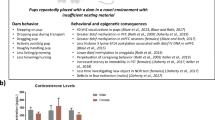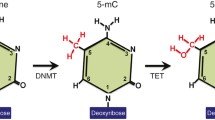Abstract
The emerging field of behavioral epigenetics is producing a growing body of evidence that early life experience and social exposure can alter the way by which genes are marked with DNA methylation. We hypothesize that changes in DNA methylation as well as other epigenetic markers could generate stable phenotypes. Early life adversity appears to result in altered DNA methylation of genes in the brain and peripheral tissues, and these changes are associated with adverse phenotypic changes. Although the data are still sparse, early epigenetic studies have provided a proof of principle that experiences and the environment leave marks on genes, and thus suggest molecular and physical mechanisms for the epidemiological concept of gene-environment interaction. The main attraction of DNA methylation for type I (TI) translational prevention science is the fact that, different from genetic changes that are inherited from our ancestors, DNA methylation is potentially preventable and reversible and, therefore, there is a prospect of epigenetically targeted interventions. In addition, DNA methylation markers might provide an objective tool for assessing effects of early adverse experience on individual risks as well as providing objective measures of progress of an intervention. In spite of this great potential promise of the emerging field of social and translational epigenetics, many practical challenges remain that must be addressed before behavioral epigenetics could become translational epigenetics.


Similar content being viewed by others
References
Cohen-Woods S, Craig IW, McGuffin P. The current state of play on the molecular genetics of depression. Psychol Med. 2013; 43(4): 673-87.
Schwab SG, Wildenauer DB. Genetics of psychiatric disorders in the GWAS era: an update on schizophrenia. Eur Arch Psychiatry Clin Neurosci. 2013; 263(Suppl 2): 147-54.
Stergiakouli E, Hamshere M, Holmans P, et al. Investigating the contribution of common genetic variants to the risk and pathogenesis of ADHD. Am J Psychiatry. 2012; 169(2): 186-94.
Murakami F, Shimomura T, Kotani K, et al. Anxiety traits associated with a polymorphism in the serotonin transporter gene regulatory region in the Japanese. J Hum Genet. 1999; 44(1): 15-7.
Binder EB, Salyakina D, Lichtner P, et al. Polymorphisms in FKBP5 are associated with increased recurrence of depressive episodes and rapid response to antidepressant treatment. Nat Genet. 2004; 36(12): 1319-25.
Eisenberger NI, Way BM, Taylor SE, et al. Understanding genetic risk for aggression: clues from the brain’s response to social exclusion. Biol Psychiatry. 2007; 61(9): 1100-8.
Waddington CH. Canalization of development and genetic assimilation of acquired characters. Nature. 1959; 183(4676): 1654-5.
Weaver IC, Cervoni N, Champagne FA, et al. Epigenetic programming by maternal behavior. Nat Neurosci. 2004; 7(8): 847-54.
Jin SG, Wu X, Li AX, et al. Genomic mapping of 5-hydroxymethylcytosine in the human brain. Nucleic Acids Res. 2011; 39(12): 5015-24.
Kriaucionis S, Heintz N. The nuclear DNA base 5-hydroxymethylcytosine is present in purkinje neurons and the brain. Science. 2009; 324(5929): 929-30.
Jenuwein T. Re-SET-ting heterochromatin by histone methyltransferases. Trends Cell Biol. 2001; 11(6): 266-73.
Strahl BD, Allis CD. The language of covalent histone modifications. Nature. 2000; 403(6765): 41-5.
Szyf M, McGowan PO, Turecki J, et al. The social environment and the epigenome. In: Worthman CM, Plotsky PM, Schechter DS, Cummings CA, eds. Formative experiences the interaction of caregiving, culture, and developmental psychobiology. Cambridge: Cambridge University Press; 2013: 53-82. 3.
Razin A, Szyf M. DNA methylation patterns. Formation and function. Biochim Biophys Acta. 1984; 782(4): 331-42.
Comb M, Goodman HM. CpG methylation inhibits proenkephalin gene expression and binding of the transcription factor AP-2. Nucleic Acids Res. 1990; 18(13): 3975-82.
Inamdar NM, Ehrlich KC, Ehrlich M. CpG methylation inhibits binding of several sequence-specific DNA- binding proteins from pea, wheat, soybean and cauliflower. Plant Mol Biol. 1991; 17(1): 111-23.
Nan X, Campoy FJ, Bird A. MeCP2 is a transcriptional repressor with abundant binding sites in genomic chromatin. Cell. 1997; 88(4): 471-81.
Weaver IC, Meaney MJ, Szyf M. Maternal care effects on the hippocampal transcriptome and anxiety-mediated behaviors in the offspring that are reversible in adulthood. Proc Natl Acad Sci U S A. 2006; 103(9): 3480-5.
Francis D, Diorio J, Liu D, et al. Nongenomic transmission across generations of maternal behavior and stress responses in the rat. Science. 1999; 286(5442): 1155-8.
Goyal NK, Teeters A, Ammerman RT. Home visiting and outcomes of preterm infants: a systematic review. Pediatrics. 2013; 132(3): 502-16.
Kaminski JW, Valle LA, Filene JH, et al. A meta-analytic review of components associated with parent training program effectiveness. J Abnorm Child Psychol. 2008; 36(4): 567-89.
Power C, Hertzman C. Social and biological pathways linking early life and adult disease. Br Med Bull. 1997; 53(1): 210-21.
Power C, Jefferis BJ, Manor O, et al. The influence of birth weight and socioeconomic position on cognitive development: does the early home and learning environment modify their effects? J Pediatr. 2006; 148(1): 54-61.
McGowan PO, Suderman M, Sasaki A, et al. Broad epigenetic signature of maternal care in the brain of adult rats. PLoS One. 2011; 6(2): e14739.
Szyf M. The early-life social environment and DNA methylation. Clin Genet. 2012; 81(4): 341-9.
Provencal N, Suderman MJ, Guillemin C, et al. The signature of maternal rearing in the methylome in rhesus macaque prefrontal cortex and T cells. J Neurosci: Off J Soc Neurosci. 2012; 32(44): 15626-15642.
Coe CL, Lubach GR. Prenatal influences on neuroimmune set points in infancy. Ann N Y Acad Sci. 2000; 917: 468-77.
Ramchandani S, Bhattacharya SK, Cervoni N, et al. DNA methylation is a reversible biological signal. Proc Natl Acad Sci U S A. 1999; 96: 6107-6112.
Bhattacharya SK, Ramchandani S, Cervoni N, et al. A mammalian protein with specific demethylase activity for mCpG DNA. Nature. 1999; 397: 579-583.
Gavin DP, Chase KA, Sharma RP. Active DNA demethylation in post-mitotic neurons: a reason for optimism. Neuropharmacology. 2013; 75: 233-245.
Rai K, Huggins IJ, James SR, et al. DNA demethylation in zebrafish involves the coupling of a deaminase, a glycosylase, and gadd45. Cell. 2008; 135: 1201-1212.
Massart R, Barnea R, Dikshtein Y, et al. Role of DNA methylation in the nucleus accumbens in incubation of cocaine craving. J Neurosci. 2015; 35: 8042-8058.
Szyf M. Prospects for the development of epigenetic drugs for CNS conditions. Nature Rev. 2015; 14: 461-474.
McGowan PO, Sasaki A, Huang TC, et al. Promoter-wide hypermethylation of the ribosomal RNA gene promoter in the suicide brain. PLoS One. 2008; 3(5): e2085.
Suderman M, McGowan PO, Sasaki A, et al. Conserved epigenetic sensitivity to early life experience in the rat and human hippocampus. Proc Natl Acad Sci U S A. 2012; 109(Suppl 2): 17266-17272.
Masten AS, Burt KB, Coatsworth JD. Competence and psychopathology, vol. 3. Hoboken: Wiley; 2006: 696-738.
Eckenrode J, Campa M, Luckey DW, et al. Long-term effects of prenatal and infancy nurse home visitation on the life course of youths: 19-year follow-up of a randomized trial. Arch Pediatr Adolesc Med. 2010; 164(1): 9-15.
Zielinski DS, Eckenrode J, Olds DL. Nurse home visitation and the prevention of child maltreatment: impact on the timing of official reports. Dev Psychopathol. 2009; 21(2): 441-53.
Hawkins JD, Kosterman R, Catalano RF, Hill KG, Abbott RD. Effects of social development intervention in childhood 15 years later. Arch Pediatr Adolesc Med. 2008; 162(12): 1133-1141.
Hill KG, Bailey JA, Hawkins JD, Catalano RF, Kosterman R, Oesterle S, Abbott RD. The onset of STI diagnosis through age 30: results from the Seattle Social Development Project intervention. Prev Sci. 2014; 15(Suppl 1): S19-S32.
Acknowledgments
The work on this transdisciplinary manuscript resulted from a National Institute of Nursing Research-funded R13 conference “Advancing Transdisciplinary Translation for Prevention of High-Risk Behaviors: Critical Thinking to Overcome Individual and Institutional Barriers” (R13NR013623-01-02). Additional support for this paper was provided in part by a grant from the National Institute on Drug Abuse (R01DA024411 01-06). The content is solely the responsibility of the authors and does not necessarily represent the official views of the NINR or NIDA. MS is supported by CIHR-MOP-42411
Author information
Authors and Affiliations
Corresponding author
Ethics declarations
The paper is a review article and discusses published studies. No primary studies with ethics requirements are discussed.
Conflict of interest
The authors declare that they have no competing interests.
Additional information
Implications
Researchers: provides a review and insight into the science of epigenetics and its implications in neuroscience.
Practitioners: introduce the practitioners to implications of the science of epigenetics on understanding, preventing, and treating behavioral disorders
Policy makers: the implications that epigenetics has on social policy
About this article
Cite this article
Szyf, M., Tang, YY., Hill, K.G. et al. The dynamic epigenome and its implications for behavioral interventions: a role for epigenetics to inform disorder prevention and health promotion. Behav. Med. Pract. Policy Res. 6, 55–62 (2016). https://doi.org/10.1007/s13142-016-0387-7
Published:
Issue Date:
DOI: https://doi.org/10.1007/s13142-016-0387-7




